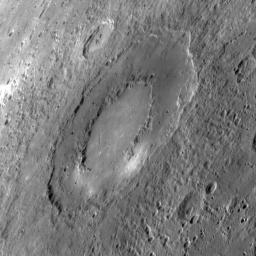
|
A Newly Imaged Basin
- Click the image above for a larger view
- Full-Res JPEG (799 x 799) (99.1 kB)
- Full-Res TIFF (799 x 799) (639.3 kB)
Caption:
This unnamed impact basin was seen for the first time yesterday during MESSENGER's third flyby of Mercury. The outer diameter of the basin is approximately 260 kilometers (160 miles). This basin has a double-ring structure common to basins with diameters larger than 200 kilometers (about 125 miles). The floor of the basin consists of smooth plains material. Concentric troughs, formed by surface extension, are visible on the basin floor, similar to those seen in Raditladi basin . Such troughs are rare on Mercury, and the discovery of such features in this newly imaged basin is of great interest to members of the MESSENGER Science Team. Crater chains produced during ejecta emplacement also can be seen emanating from the basin.
Date Acquired:
September 29, 2009
Image Mission Elapsed Time (MET):
162744150
Instrument:
Narrow Angle Camera (NAC) of the Mercury Dual Imaging System (MDIS)
Resolution:
0.40 kilometers/pixel (0.25 miles/pixel)
Scale:
The basin is approximately 260 kilometers (160 miles) in diameter
Spacecraft Altitude:
15,600 kilometers (9750 miles)
Background Info:
These images are from MESSENGER, a NASA Discovery mission to conduct the first orbital study of the innermost planet, Mercury. For information regarding the use of images, see the MESSENGER image use policy .
Cataloging Keywords:
| Name | Value | Additional Values |
|---|---|---|
| Target | Mercury | |
| System | ||
| Target Type | Planet | |
| Mission | MESSENGER | |
| Instrument Host | MESSENGER | |
| Host Type | Orbiter | |
| Instrument | Mercury Dual Imaging System (MDIS) | |
| Detector | Narrow Angle Camera (NAC) | |
| Extra Keywords | Crater, Grayscale, Impact | |
| Acquisition Date | ||
| Release Date | 2009-09-30 | |
| Date in Caption | 2009-09-29 | |
| Image Credit | NASA/Johns Hopkins University Applied Physics Laboratory/Carnegie Institution of Washington | |
| Source | photojournal.jpl.nasa.gov/catalog/PIA12267 | |
| Identifier | PIA12267 | |
